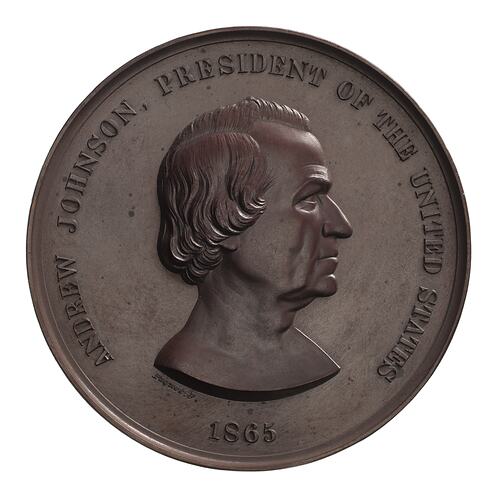Summary
Peace Medal, American Indian, issued by President Andrew Johnson, United States of America, 1865. Peace medals played a significant role in relations between the United States government and the population Indigenous to North America (the terms Native American and American Indian are also used by government and cultural institutions in the USA).
Following the British and French practice of handing out silver medals to tribal chiefs, George Washington began a policy of presenting peace medals to American Indian leaders at treaty signings and other formal ceremonies. Every subsequent American president from Thomas Jefferson to Benjamin Harrison is represented on an American Indian peace medal, with the exception of William Henry Harrison. The medals were often produced in different sizes according to the rank of the recipients.
This example is a bronze replica created by the Philadelphia federal mint using the original dies. The series began in 1842 with the Thomas Jefferson medal.
Obverse Description
A bust of the President facing right; around, ANDREW JOHNSON PRESIDENT OF THE UNITED STATES 1865.
Reverse Description
Two figures clasping hands before a bust of George Washington; the figure on the right represents the United States, she holds a flag and stands among symbols on industry; in the background behind her, a steam train; the figure on the left represents American Indians, he stands among dropped weapons; in the background behind him an Indian on horseback hunts buffalo with a bow and arrow; on the stand within an olive wreath, PEACE.
Edge Description
The edge is plain
More Information
-
Collecting Areas
-
Acquisition Information
Transfer from National Gallery of Victoria (NGV), United States of America: Government
-
Date Issued
1865 AD
-
Issued By
-
Person Depicted
President Andrew Johnson - United States Government, United States of America, 1865
-
Material
Copper
-
Axis
12
-
Classification
-
Category
-
Discipline
-
Type of item
-
Dimensions
63 mm (Outside Diameter)
-
Shape
Round
-
Keywords
Indian Peace Medals, Peace, Native Americans, Indigenous Peoples, Indigenous Issues


